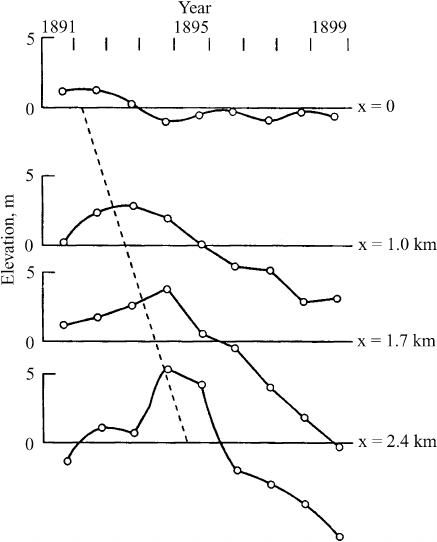Fowler A. Mathematical Geoscience
Подождите немного. Документ загружается.


610 9 Magma Transport
By choosing l =
√
C and defining suitable scales for t and h, show that the
model can be written in the dimensionless form
h
t
+(h
3
)
x
=h
xxt
+ε
h
3
−r
h
3
xx
,
where
ε =
2ρ
sm
g
ρ
m
L
kη
s
η
m
1/2
.
Show that ε 1, and deduce that h is approximately described by the modi-
fied BBM equation
8
h
t
+3h
2
h
x
=h
xxt
.
9.5 A pod of melt in a viscous porous medium is described by the scaled, gener-
alised BBM equation
h
t
+3h
2
h
x
=h
xxt
,
in which we assume that h → 0asx →±∞. Show that
∞
−∞
hdx = M is
conserved, and that travelling wave solutions exist of the form h =φ(η) with
η =x −ct, providing
φ
2
=φ
2
−
φ
4
2c
,φ(±∞) =0.
Deduce that φ =
√
2c sechη, and thus that c =
M
2
2π
2
.
Show also that if one only requires h to be bounded at infinity, then there is
a one parameter family of periodic solutions for each c>0.
9.6 A magma-filled crack L of width h propagates through the lithosphere, and is
described by the dimensionless equations
∂h
∂t
+
∂
∂x
h
3
1 +δ
∂Π
∂x
=0,
Π =
1
2π
−
L
∂h
∂s
ds
s −x
,
where Π is the underpressure in the crack, which is assumed to lie in −l<x<
l, and x points vertically upwards. Essentially, we view x =0 as the base of
the lithosphere, so that the physical crack is in x>0, with its virtual extension
in x<0 representing conditions of symmetry about x =0.
Show that exact similarity solutions can exist in terms of a similarity vari-
able η = xt
1/3
, and write down the equations for the similarity functions H
and P corresponding to h and Π , respectively. Explain why such a similarity
solution is unlikely to represent a physically appropriate solution.
8
The equation is closely related to that studied by Benjamin et al. (1972) as a model for long waves
in shallow water. We may infer that the present equation for h is well-posed.

9.9 Exercises 611
Show that if δ is small and is ignored, then a similarity solution exists for
input fluxes q|
x=0+
= h
3
= t
ν
, and show that the appropriate similarity vari-
able is η =
x
t
β
, and find β in terms of ν. Find the equation satisfied by H(η),
the appropriately rescaled definition of h. By writing H =η
1/2
G and τ =lnη,
show that G
(τ ) =F(G), where you should define the function F . Show that
a solution is possible in which G ∼
1
η
1/2
for large η, and thus we can sup-
pose H = 1atx = 0. In this case, show that if 0 <β<1, then H ∼
η
3
as
η →∞, while if β>1, H ∼ H
c
+(η
c
−η)
1/2
as η →η
c
for some finite η
c
.
Deduce that a physically meaningful solution of the model, in which a finite
crack grows, only exists if ν>0, and give an expression for the crack front as
a function of time.
9.7 The width h of a crack in an elastic medium and its underpressure Θ are
determined near the crack tip by the dimensionless equations, on [0, ∞],
Θ
X
=1 −
1
h
2
,
Θ =
1
π
−
∞
0
∂h
∂ξ
dξ
ξ −X
,
subject to
h ∼2λ
√
X as X →0,
h →1asX →∞.
Use complex variable methods to invert the integral equation, and by integrat-
ing the result, find an integral expression for h. Using integration by parts,
derive the nonlinear integral equation for h,
h(X) =
1
π
∞
0
K(x,ξ)
1
h
2
−1
dξ,
where
K(x,ξ) =(x −ξ)ln
√
x +
√
ξ
√
x −
√
ξ
−2
xξ.
Deduce that if h ∼2λ
√
X as X →0, then
λ =
2
π
∞
0
ξ
1
h
2
−1
dξ.
Show also that
h ∼1 +
1
2πX
2
as X →∞,
and deduce that the fracture has a bulbous nose. Sketch the expected form of
the shape (see also Spence et al. 1987).

612 9 Magma Transport
9.8 According to Muskhelishvili (1953, pp. 73 ff.), the behaviour of the Cauchy
integral
Φ(z) =
1
2πi
l
−l
φ(t)dt
t −z
near the end z =l is given by
Φ ∼−
φ
∗
cosecγπ
2i(z −l)
γ
,
if
φ ∼
φ
∗
(l −x)
γ
as x →l with 0 <γ <1 (and φ
∗
is constant).
Show also that if
Ψ(z)=
1
2πi
l
−l
ψ(t)dt
t −z
,
and ψ(l) =0, then
Ψ
(z) ∼
1
2πi
l
−l
ψ
(t) dt
t −z
+O(1)
as z →l.
As x →l+ on y =0, we have σ
2
−iτ ∼2Ω
, where
Ω ∼
1
2πi
l
−l
2iμ
1 +κ
h(s) ds
s −z
,
in which κ =
λ+3μ
λ+μ
, and also ν =
λ
2(λ+μ)
. Show that if h ∼ c(l − x)
1/2
as
x →l−, then
σ
2
(x, 0) ∼
K
√
2π(x −l)
as x →l+,
where
K =
μc
√
π
2
√
2(1 −ν)
.
9.9 The crystal nucleation rate of a liquid is given by
I =K
exp
−
H
RT
exp
−
G
RT (T )
2
,
where K
is a rate constant, G
and H are activation energies, T is temper-
ature, and T = T
L
−T is the undercooling below the liquidus temperature
T
L
. By writing
T =T
L
−(T
c
)θ,

9.9 Exercises 613
show that I can be written in the form
I =k
exp
−
δθ
ε(1 −δθ)
exp
−
1
θ
2
(1 −δθ)
,
provided we choose
T
c
=
G
RT
L
1/2
,
and define the parameters k
, δ and ε.
Use the values T
L
= 1200 K, K
= 10
8
,
H
R
= 2 ×10
4
K,
G
R
= 10
5
Kto
find typical values of T
c
, ε, δ and k
, and hence show that δ ε, and thus
that
I ∼k
exp
−
1
θ
2
if θ ∼O(1),
I ∼k
e
−Θ
, if Θ ≡
δθ
ε
∼O(1).
Write down a uniform approximation for I .WhyisT
c
a measure of the
critical undercooling?
9.10 The supercooling θ below the liquidus in a magma chamber satisfies the equa-
tion
θ
t
=θ
xx
−St φ
t
,
where
φ =1 −exp
−
1
3
Z
3
,Z
t
=H(θ)Y(θ),
and H(θ) is the Heaviside step function. The initial and boundary conditions
are
θ =θ
∞
≥0,Z=0att =0,
θ =θ
0
< 0atx =0,
θ
x
=0atx =
1
ε
.
Assume that θ
0
,θ
∞
, St ∼O(1), ε 1. By writing x =
X
ε
, t =
T
ε
2
, Z =
z
ε
2
,
show that a suitable outer approximation for θ and z is given by
θ
T
=θ
XX
,z
T
=H(θ)Y(θ),
in 0 <X<S(T)and S(T ) < X < 1, where the outer solution satisfies θ =
z =0onX =S. Show that the outer solution for z in X<Sis
z =
T
S
−1
(X)
Y
θ(X,T
)
dT
,

614 9 Magma Transport
where S
−1
is the inverse function of S. What is the outer solution for z in
X>S?
For T close to (and greater than) S
−1
(X), show that
z ≈
1
2
T −S
−1
(X)
2
θ
XX
|
X=S−
,
and deduce that a suitable rescaling near X =S is obtained by writing
X =S(T ) +εξ, θ =εΘ, z =ε
2
Z,
and that the inner problem can be written, to leading order, as
0 =Θ
ξξ
+St
˙
Sφ
ξ
,
−
˙
SZ
ξ
= H(Θ)y(Θ),
where we write Y(εΘ)=εy(Θ), supposing that y ∼O(1).
Show that the matching conditions for Θ and Z are
Θ ∼g
−
ξ, Z ∼
ξ
2
2
˙
S
2
Θ
XX
|
X=S−
as ξ →−∞,
Θ ∼g
+
ξ, as ξ →∞,
(∗)
where g
±
=θ
X
|
X=S±
.
[To compute the condition on Z, you will need to show that for 0 <T −
S
−1
(X) 1,
T −S
−1
(X) ≈−
εξ
˙
S
.]
Hence show that S satisfies the Stefan condition
St
˙
S =[θ
X
]
+
−
.
Suppose that y(Θ) =Θ. Show that Z satisfies
−
˙
SZ
ξξ
=g
−
+St
˙
S exp
−
1
3
Z
3
,
and explain why, if g
+
> 0, appropriate boundary conditions are
Z =Z
ξ
=0atξ =0.
Show further that the solution for Z satisfies the second condition in (∗) au-
tomatically (remember that θ[S(T ),T ]≡0). What are appropriate conditions
if g
+
=0?
Sketch or compute the solution for Z.

9.9 Exercises 615
9.11 Dimensionless equations describing double-diffusive convection are given by
∇.u = 0,
1
Pr
u
t
+(u.∇)u
=−∇p +∇
2
u +Ra T
ˆ
k −Rs c
ˆ
k,
T
t
+u.∇T =∇
2
T,
c
t
+u.∇c =
1
Le
∇
2
c,
where u is the fluid velocity, p is pressure, T is temperature, c is concentration,
and the parameters are the Rayleigh number Ra, the solutal Rayleigh number
Rs, the Prandtl number Pr and the Lewis number Le.
Assuming a two-dimensional flow, so that there is a stream function ψ
satisfying
u =(−ψ
y
,ψ
x
),
suppose that the flow is driven by prescribed temperature and salinity differ-
ences between the upper and lower surfaces of a stress-free box, so that the
boundary conditions take the form
ψ =∇
2
ψ =0atz =0, 1,
T =c =0atz =1,
T =c =1atz =0.
Write down the steady state in which u = 0, and let C and θ denote per-
turbations to c and T , respectively. Assuming C,θ,ψ 1, write down the
linearised equations and boundary conditions for the flow. By seeking solu-
tions proportional to exp(ikx +σt)sin mπz, show that
σ +K
2
Pr
σ +K
2
σ +
K
2
Le
+k
2
Pr
(Rs −Ra)σ
K
2
+Rs −
Ra
Le
=0,
where
K
2
=k
2
+m
2
π
2
.
Show that this can be written in the form
σ
3
+aσ
2
+bσ +c = 0,
where
a = K
2
Pr +1 +
1
Le
,
b =K
4
Pr +
1
Le
+
Pr
Le
+
k
2
K
2
Pr(Rs −Ra),

616 9 Magma Transport
c =
K
6
Le
Pr +k
2
Pr
Rs −
Ra
Le
.
Deduce that direct instability (σ>0) occurs if
Ra −Le Rs >R
c
=
27π
4
4
,
and oscillatory instability occurs if
Ra >
(Pr +λ)Rs
1 +Pr
+
(1 +λ)(Pr +λ)
Pr
R
c
,
where λ =
1
Le
.

Chapter 10
Glaciers and Ice Sheets
Glaciers are huge and slow moving rivers of ice which exist in various parts of the
world: Alaska, the Rockies, the Alps, Spitzbergen, China, for example. They drain
areas in which snow accumulates, much as rivers drain catchment areas where rain
falls. Glaciers also flow in the same basic way that rivers do. Although glacier ice is
solid, it can deform by the slow creep of dislocations within the lattice of ice crystals
which form the fabric of the ice. Thus, glacier ice effectively behaves like a viscous
material, with, however, a very large viscosity: a typical value of ice viscosity is
6 bar year (in the metre–bar–year system of units!). Since 1 bar = 10
5
Pa, 1 year
≈3 ×10
7
s, this is a viscosity of some 2 ×10
13
Pa s, about 10
16
times that of wa-
ter. As a consequence of their enormous viscosity, glaciers move slowly—a typical
velocity would be in the range 10–100 m y
−1
(metres per year), certainly measur-
able but hardly dramatic. More awesome are the dimensions of glaciers. Depths
of hundreds of metres are typical, widths of kilometres, lengths of tens of kilome-
tres. Thus glaciers can have an important effect on the human environment in their
vicinity. They are also indirect monitors of climate; for example, many lithographs
of Swiss glaciers show that they have been receding since the nineteenth century,
a phenomenon thought to be due to the termination of the ‘Little Ice Age’ which
lasted from about 1500 to about 1900.
Where glaciers are the glacial equivalent of rivers, i.e. channelled flow, ice sheets
are the equivalent of droplets, but altogether on a grander scale.
1
When an entire
continent, or at least a substantial portion thereof, has a polar climate, then snow
accumulates on the uplands, is compressed to form ice, and flows out to cover the
continent, much as a drop of fluid on a table will spread under the action of gravity.
However, whereas droplets can reach a steady state through the contractile effect of
surface tension, this is not relevant to large ice sheets. In them, equilibrium can be
maintained through a balance between accumulation in the centre and ablation at
the margins. This can occur either through melting of the ice in the warmer climate
1
Ice caps are smaller scale sheet flows, such as the Vatnajökull ice cap in Iceland, whose horizontal
dimension is about 100 km.
A. Fowler, Mathematical Geoscience, Interdisciplinary Applied Mathematics 36,
DOI 10.1007/978-0-85729-721-1_10, © Springer-Verlag London Limited 2011
617

618 10 Glaciers and Ice Sheets
at the ice margin, or through calving of icebergs. (Indeed, the same balance of ac-
cumulation at higher elevations with ablation at lower elevations is responsible for
the normal quasi-steady profile of valley glaciers.)
There are two major ice sheets on the Earth, namely those in Antarctica and
Greenland (the Arctic is an ocean, and its ice is sea ice, rarely more than three
metres thick). They are on the order of thousands of kilometres in extent, and kilo-
metres deep (up to four for Antarctica). They are thus, in fact, shallow flows, a fact
which greatly facilitates the solution of mathematical models for their flow. Possibly
more famous are the ice sheets which covered much of North America (the Lauren-
tide ice sheet) and northern Europe (the Fennoscandian ice sheet) during the last ice
age. Throughout the Pleistocene era (that is, the last two million years), there have
been a succession of ice ages, each lasting a typical period of around 90,000 years,
during which global ice sheet volume gradually increases, interspersed with shorter
(10,000 year) interglacials, when the ice sheets rapidly retreat. The last ice age fin-
ished some ten thousand years ago, so that it would be no surprise if another were
to start now. Perhaps the Little Ice Age was indeed the start of ice sheet build-up,
only to be interrupted by the Industrial Revolution and the resultant global warming:
nobody knows.
Further back in Earth’s geologic history, there is evidence for dramatic, large
scale glaciation in the Carboniferous (c. 300 My (million years) ago), Ordovician
(c. 500 My ago), Neoproterozoic (c. 600–800 My ago) and Huronian (c. 2,500 My
ago) periods. In the Neoproterozoic glaciation, it seems that the whole landmass
of the Earth may have been glaciated, leading to the concept of ‘snowball Earth’.
It was following the shrinkage of the global ice sheet that the explosion of life on
Earth started.
2
While the motion of ice sheets and glaciers can be understood by means of vis-
cous theory, there are some notable complications which can occur. Chief among
these is that ice can reach the melting point at the glacier bed, due to frictional heat-
ing or geothermal heat input, in which case water is produced, and the ice can slide.
Thus, unlike an ordinary viscous fluid, slip can occur at the base, and this is deter-
mined by a sliding law which relates basal shear stress τ to sliding velocity u
b
and
also, normally, the effective pressure N = p
i
− p
w
, where p
i
and p
w
are ice and
water pressures. The determination of p
w
further requires a description of the sub-
glacial hydrology, and thus the dynamics of ice is intricately coupled to other phys-
ical processes: as we shall see, this complexity leads to some exotic phenomena.
10.1 Dynamic Phenomena
10.1.1 Waves on Glaciers
Just as on rivers, gravity waves will propagate on glaciers. Because the flow is very
slow, they only propagate one way (downstream), and at speeds comparable to the
surface speed (but slightly faster). These waves are known as surface waves, as they
2
Snowball Earth was discussed in Chap. 2.

10.1 Dynamic Phenomena 619
Fig. 10.1 Changes of mean
surface elevation of Mer de
Glace, France, along four
cross-profiles over a period of
9 years. The broken line
corresponds to a wave
velocity of 800 m/a.
Reproduced from Lliboutry
(1958a), by permission of the
International Association of
Hydrological Sciences
are evidenced by undulations of the surface: an example is shown in Fig. 10.1.They
are examples of kinematic waves, driven by the dependence of ice flux on glacier
depth.
A more exotic kind of wave is the ‘seasonal wave’. This has no obvious counter-
part in other fluid flows. It consists of (sizeable) perturbations in the surface velocity
field which propagate down-glacier at speeds in the order of 20–150 times the sur-
face speed. There is no significant surface perturbation, and these waves must in
fact be caused by variations of the basal sliding speed due to annual fluctuations in
the basal water pressure. Although well known and reported at the turn of the cen-
tury, little attention has been paid to these waves in recent years. Figure 10.2 shows
measurements of Hodge on Nisqually Glacier which indicates the rapid passage of
a velocity wave downstream.
Mention should also be made of wave ogives, although we will not deal with
them here. They are bands (also known as Forbes bands) which propagate below
ice-falls, and are due to the annual ablation cycle.
10.1.2 Surges
Perhaps the most spectacular form of wave motion is the glacier surge. Surges are
large scale relaxation oscillations of the whole length of a glacier. They are roughly
